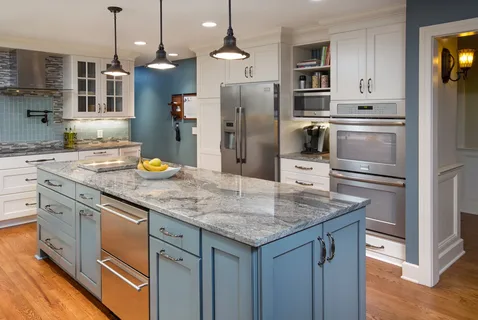You have finally designed the kitchen of your dreams and are making tasty dishes in it every day. Every part is working properly but guess what comes next? The dirt and debris accumulating in your space.
Cabinets are a very vital part of providing space and shelter in your kitchen. It also means that they are the perfect spot for accumulated dust. They are directly exposed to various elements that can degrade them. You have to have regular clean sessions for them to be more long-lasting. You can not just regularly wash or wipe your kitchen cabinets. It requires good attention regarding their material type cleanup.
We have prepared a complete guide for cleaning your kitchen cabinets for you. So do read it and clean your cabinet properly.
Understanding the Cleaning Material
For maintaining the gleaming brilliance of your cabinets, proper care and maintenance is very important. Fortunately, you can keep your cabinets looking new with a little attention. Most of the kitchen cabinets are made up of some kind of wood and timber. They range from plywood to thermofoil. It is crucial to properly take care of finished wood for long-lasting cabinets.
- Moisture is one of the most threatening things for wood finishes. It is important to keep moisture minimum when cleaning the wooden cabinets. You can start gradually cleaning some portions of cabinets at one time rather than washing the whole cabinet. Use a soft material wet cloth to clean the surface then dry with another cloth immediately. A little water and soft cloth can get your job done effectively. Some stains are hard to remove. You can use mild soaps to remove them. Just make sure to dry them up after cleaning.
- Laminated and faux wood cabinets are also available in the market. You can use a dry cloth to wipe that dirt away
- Painted or stained cabinets also require minimum moisture for cleaning. Do not aggressively wipe or scratch them to remove their paint coats.
- Glass cabinets are much easier to wash and can tolerate moisture better. You can clean them with a wet washcloth or detergents.
Read more about How do You Organize Kitchen Cabinets
Choose the right cleaning products
Most of the time using a damp cloth for cleaning is all that you need. But sometimes you can mix some mild soap for cleaning. Here are some do’s and don’ts of kitchen cleaning.
Do’s of cabinet cleaning
You have to regularly wipe the dust and debris present on the cabinets. You may not notice but grease and oil can also get accumulated on the surface. They can become big balls of grime if you are not paying enough attention. Make sure to remove them particularly if you have an open-concept floor plan. Use a lint-free washcloth with mild shampoo to clean them. After you have cleaned the surface make sure to dry them for any product residue.
Don’ts of cabinet cleaning
Using harsh chemicals for cleaning cabinets is a big No. You do not want to damage your cabinet’s finishing by using abrasive agents.
You have to avoid these things to prevent damage
- Products containing petroleum, ammonia, acids or bleach
- Waxing products having silicone
- Harsh soaps and detergents
- Clothes with strong moisture agents
- Vinegar, baking soda, or olive oil
- Your regular washing clothes or sponges
Hardware cleanup
With proper cleaning, you cannot forget about the hardware. You have to wipe the doorknobs and pull out drawers for thorough cleaning. Thoroughly dry the hardware with a dry soft cloth once you have washed them. Do not touch the door with oily and greasy hands, it can stay like that for a long time. You also need to oil the hinges sometimes with the help of Q-tips so that the doors are not jammed from rust and are properly working. Silver brass and polishes can be damaged with the use of harsh chemicals, so make sure to avoid them.
Be gentle
Using very hard and abrasive materials and scrubs can remove the polish of your cabinets making them more exposed to deterioration. For tight corners or small spaces, you can use a soft-bristled toothbrush to get in every nook and corner. Do not reuse the washcloths you have already cleaned your stove and oven with. It can cause stains or blistering. Softly wipe the painted cabinets so that it does not cause splinters.
Post clean care
Regular detailed sessions of cleaning are important but try to limit the dirt activities after major cleaning as well. Mild cleaning after putting out things from cabinets can help to prevent big clean-ups. Make sure you are not spilling or keeping anything in to harm your cabinets.
Prolonged exposures to sunlight and heat can fade the color and damage your cabinet’s finish. Make sure to close your cabinet doors while using heat appliances. Limit the use of moisture in your cabinets to avoid decay. It is best to give regular cleaning to your cabinets every week. If dust, oil, food, or moisture is present for a long time, it can cause great damage to your cabinets.
Damage and scratches
It does not matter how much you try to protect your cabinets, incidents are bound to happen. You can get scratches and nicks on your cabinets often. Express Wood Cabinetry provides a premium range of services for these purposes. We can fix your broken cabinets or install all kinds of new cabinets.
Conclusion
Kitchen cabinets are a very convenient solution for space and storage for kitchens. They need to maintain a regular cleaning habit. Understanding the material and different agents on cabinets is a great start for cleaning up. Cleaning gently is the most acceptable thing for cabinets. Whereas mild detergents are encouraged, avoiding harsh chemicals and materials for cleaning is advisable. What kind of cleaning you do is going to contribute to the longevity of your cabinets. We hope to completely guide you on kitchen cabinet cleaning through our extensive work and hope for the best results.

